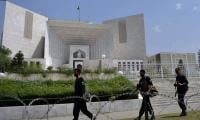For the National Disaster Management Authority (NDMA) to do any justice to its name, it has to meet three criteria. It has to have a nation-wide presence, it has to possess the core competency of disaster management, and it has to have some authority at times of a national disaster. At present, it is devoid of all three.
Most national institutions such as the National Highways Authority, Federal Public Service Commission and National Accountability Bureau, to name but a few, have offices at least in all four provincial capitals. The NDMA only has one in the entire country, based in Islamabad. This illustrates the first limitation of this top disaster management body – it does not have a nation-wide presence.
Pakistan has as many disaster response bodies as the number of disasters the country risks facing. Each province has its own Provincial Disaster Management Authority (PDMA). For AJK, there is a State Disaster Management Authority (SDMA). Districts have their own District Disaster Management Authorities (DDMAs). The PDMAs and DDMAs neither draw their budgets from the NDMA nor are they obliged to take orders from it.
A government’s response to disaster can be classified under three heads: Relief, Rehabilitation and Reform. When it comes to providing relief, the NDMA does not possess the capacity to service the length and breadth of the country. Resultantly, the Poverty Alleviation and Social Safety Division provides relief. When it comes to rehabilitation, the NDMA lacks mandate for rehabilitation works such as constructing homes post-earthquake, or repairing dykes post a devastating flood. The third leg of disaster response – known as reform – involves taking measures to ensure that subsequent disasters of a similar nature do not cause as much damage. On this one, the NDMA fares only as good as it does on the first two heads.
It is quite surprising that to this day, the NDMA has no specialist cadre of its own, when it comes to disaster management. Its officers are sourced via deputation from various other government departments, and others still are hired at contractual appointments; but no specialized cadre of its own.
Even the decision about whether or not to go for a lockdown amidst a pandemic does not rest with the NDMA. The decision about which province gets how much supply of relief goods does not rest with the NDMA. No one is required by law to seek the NDMA’s NOC for say setting up a nuclear power plant near populated areas in the country, or for operating inbound international flights amidst a pandemic. The de-facto role of the NDMA at the moment is that of receiving incoming humanitarian aid supplies at the airport – a role which prior to the NDMA, was performed by any cabinet member.
On ground, the deputy commissioners continue to lead the government’s disaster response effort. It is they who are setting up quarantine camps, enforcing lockdown, ensuring provision of PPEs to hospitals and overseeing smooth operations at the cash disbursement centers for the low-income segment. All this is in addition to their routine duties which include managing the district revenue, preparing for dengue virus response, ensuring price control of essentials and countless other tasks. In the realm of disaster management, little if anything, has changed post the creation of the NDMA.
In 2016, for some reason, yet another body was added to the portfolio of Pakistan’s disaster management framework. The National Disaster Risk Management Fund took on a loan from the ADB to invest in the nation’s disaster response preparedness. How that has contributed in our disaster preparedness is for all to see. The best time to think about preparedness is before a disaster strikes. Since that opportunity is lost, this pandemic should be used as an impetus to unfreeze the status quo with respect to disaster management, change what needs improvement and then refreeze for good.
The writer is a freelance contributor. Email: shehryaraziz100@hotmail.com
The government can directly influence economic activity through current and capital expenditure
A view of the Supreme Court of Pakistan. — Supreme Court website/FileWhat kind of firewall does the judiciary...
Indian soldiers stand alongside a barbed wire on the Line of Control. — AFP/FileAnti-Pakistan propaganda remains a...
A representational image showing farmers harvesting wheat crops in a field. — AFP/FileThere is a clear, lasting, and...
Pakistan's first president Major General Iskander Mirza while speaking with the Turkish Prime Minister Adnan...
Prime Minister Shehbaz Sharif pictured alongside President Asif Ali Zardari. — INP/FileBeing a man of action in...







